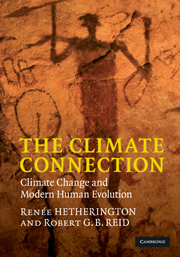Book contents
- Frontmatter
- Contents
- Foreword
- Preface
- Acknowledgements
- 1 Introduction
- Part I Early human history
- Part II Climate during the last glacial cycle
- Part III The interaction between climate and humans
- 7 The interaction between climate and humans
- 8 Climate and agriculture
- 9 Climate and our future
- Appendices: The biological background to the story of evolution
- References
- Index
- Plate section
8 - Climate and agriculture
Published online by Cambridge University Press: 05 August 2012
- Frontmatter
- Contents
- Foreword
- Preface
- Acknowledgements
- 1 Introduction
- Part I Early human history
- Part II Climate during the last glacial cycle
- Part III The interaction between climate and humans
- 7 The interaction between climate and humans
- 8 Climate and agriculture
- 9 Climate and our future
- Appendices: The biological background to the story of evolution
- References
- Index
- Plate section
Summary
Introduction
Climate and agriculture have complex connections. In Chapters 6 and 7 we learned how a changing climate influences vegetation. Climate limits what can be grown. Climate change can also cause catastrophic crop failure; today, anthropogenic ‘global warming’ is blamed for the biggest droughts in hundreds to thousands of years and impoverished crops. These kinds of connections strongly suggest that climate change had a significant influence on the origin of agriculture and its subsequent development. The early evolution of farming had nothing to do with anthropogenic global warming, but linkages between a changing climate and the capacity to grow things in the past and present are clear.
Milankovic cycles, positive feedbacks and ENSO (El Niño–Southern Oscillation) events influence climate change and the productivity and extent of vegetation. During the post-glacial melting of ice in the late Pleistocene and early Holocene, two huge escapements of fresh water into the Atlantic abruptly slowed the northerly circulation of warm sea water and caused northern hemisphere surface temperatures to drop. The first freshwater influx, during the Younger Dryas cooling event, correlates with early attempts at farming. The second, also associated with a cooler and drier climate, affected the ranges and species of crops that could be raised. Volcanic eruptions also affect productivity and the extent of vegetation. Volcanic eruptions had local effects that early humans could step away from, provided there was somewhere to step that was not already densely populated.
- Type
- Chapter
- Information
- The Climate ConnectionClimate Change and Modern Human Evolution, pp. 235 - 268Publisher: Cambridge University PressPrint publication year: 2010



